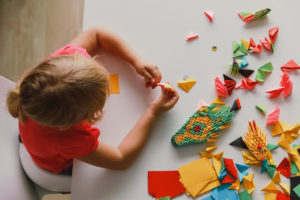
Why you should teach your kids the art of origami
Most of us don’t think much of fancy napkins and pizza boxes. We disregard them just like we do paper bags. However, they all have something special in common. They are direct descendants of an ancient Far-East art form — origami.
Although this art form is as old as the Japanese and Chinese cultures themselves — which are pretty much ancient — it has a special place in modern times. Namely, we can use it to teach our kids complex concepts like geometry and fractions.
But it’s not just about math. Origami can help develop their thinking and problem-solving skills. Allow us to, therefore, explain the importance of teaching origami to kids by listing a couple of ways that it makes regular subjects more exciting for kids.
Origami Requires Patience
The pros of teaching origami to kids are nothing new. People have been aware of this for a very long time. In the West, we have been using it to entertain our little ones since the 19th century.
One of the main benefits of folding papers and constructing complex figures when it comes to kids is that they learn about being patient. Even creating simple origami figures requires calmness, concentration, and stillness.
As you probably know, most kids lack all three of those qualities. They aren’t interested in any of them, and that’s understandable. But with the prospect of having a toy in their hands by the time they’re done, even Dennis the Menace would be patient and willing to learn.

Kids Develop Mathematical Skills
When you think about elementary school, not many things are as bad as geometry classes. Well, aside from bullies, of course. Either way, geometry is one of the math skills that most American kids have trouble with. Even the National Center for Education Statistics suggests that. Luckily, origami is a great way to help kids overcome it. Folding a piece of paper can help youngsters better understand formulas, labels, and space in geometry.
Teaching children to create origami models can also help with fractions. This mathematical concept is pretty scary in the first few grades, but they don’t have to be if it’s fun. And to make it so, many teachers include simple types of origami in their lesson plans.
Problem-Solving Skills Are Tested When Doing Origami
Another benefit of learning origami is developing problem-solving skills. Several studies suggest that kids who understand folding origami papers have it better when it comes to spatial visualization. That means that they are way better at solving problems, comprehending complex forms, and are more observant of their surroundings.
Having your kids observe different forms in nature and then trying to reconstruct them step-by-step with paper at home isn’t just playing. It can help ensure they go on and have successful careers as engineers, architects, or scientists. The benefits of origami are improved problem-solving skills that will come in handy regardless of the career path.
If you think about it, it seems pretty logical. Each paper fold that leads to a meaningful result requires solving a spatial problem in your mind. And the more kids do it, the more prone they become to overcoming complexities, which they can use in other aspects of their lives. It doesn’t have to be just math and the school curriculum.
Origami Improves Kids’ Creativity
When talking about origami, most articles focus on math and engineering. And that’s okay because there’s a lot of that going on while folding paper. Still, fine motor skills like these can be used for other, more artistic expressions just as well. By learning origami, kids can encourage and develop their creativity in a big way.
In the beginning, kids doing origami shouldn’t be overly complex. They should, instead, focus on creating simple forms like various kinds of flowers. However, once they figure out the basics, parents should encourage them to start recreating objects they see in nature. From trees and bushes to animals and people, they can explore anything they wish.

Aside from making them happy by doing anything they want, focusing on non-typical origami will influence their creativity. But this broadening of their views won’t stop at paper cranes, swans, and other majestic birds. It will translate into burgeoning creativity in other art forms as well, including drawing, painting, and much more.
Kids Test Their Mental Coordination
When someone mentions origami, the last thing that you’d think about is physical and mental exercise. Most imagine models of birds and other animals, or fancy napkins in expensive restaurants. However, we must disappoint you. Origami art is one of the finest examples of exercise there is. It helps kids with coordination, stimulating their hands and brains.
To create even the simplest of forms, one must have great skills and nimble fingers. But the engine behind the tips of your thumbs is the brain. Without its proper functioning, we wouldn’t be able to hold a cup of water, let alone create origami. Therefore, challenging kids in their early years will boost their development by connecting their brain and hand activity.
On the other hand, there’s yet another benefit to origami — it’s a perfect way to relax. Sure, kids might not be living under the same stress as adults do, but they do have unique struggles. Fighting your way through school curriculum and the jungle of the schoolyard can be quite frustrating when you’re ten. Yet, origami can serve as a perfect distraction.